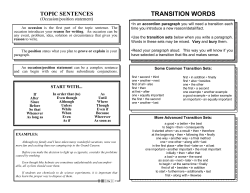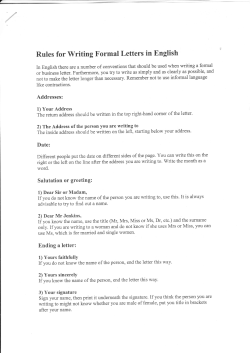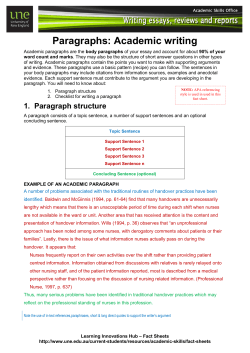
Document 185941
Explicitly teaching Grade 5/6 students how to independently use synonyms and paraphrasing when reading a fiction or non-fiction text will lead to improved comprehension results. Paraphrasing Teaching Sequence Assumption of students prior knowledge: Being students in Grade 5/6, most have developed independent reading strategies by now. They should be accurate text decoders, apart from those students with specific intervention needs. At this level they would have experienced paraphrasing when reading, but they may not have focused on it explicitly, they may have worked with putting things into their own words. Sentence level strategies should be in place by this level. How will the key behaviours taught be stored in memory and transferred? Teaching this concept as a whole class will make it easily transferable to other curriculum areas and students will have a shared dialogue about the strategy. Repeated revision of the RAP acronym will reinforce the concepts, and repeated paraphrasing of text at sentence and paragraph level will help. Materials: PowerPoint presentation (created by Natalie Thorne, uses texts from www.ziptales.com, http://www.abc.net.au/btn/, and http://www.pearsonlongman.com.) Synonyms Class Game – purchased from www.teachthis.com.au (not an essential material) John Munro Paraphrasing Strategy lesson outlines (Munro, 2006). Poster showing the RAP acronym to use as a visual aide during the teaching sessions. Strategy Introduction: We are going to learn about a strategy that will help you when you are comprehending something you have read. It is called paraphrasing. To paraphrase you will need to read a sentence, then say it in your own words. We will start working on paraphrasing a single sentence, then move onto pairs of sentences and eventually paraphrasing paragraphs. We will start by looking at a language feature that will be useful when paraphrasing. This feature is called synonyms. Our first session will focus only on synonyms as an introduction. Session 1 2 Learning activities Synonyms: Define what a synonym is in simple terms- synonyms are words that have almost the same meaning. Make it clear that when we list synonyms we are not creating a list of describing words. Play teacher participation match up game. I have ‘start’ who has a synonym for this? Words keep linking through synonyms with each child having an individual card. Ask students to think of a list of synonyms for the words bad, woman, and strange. Put the words into a sentence context so they ensure it is semantically correct. Students will then share their words with the whole class. Discuss with a partner why synonyms would help us read and understand a text, share thoughts with the class. Give the students a few sentences, they then need to change some of the words with synonyms that would fit in the sentences. Introduce the concept of paraphrasing by explaining what it is, ask the students to discuss how paraphrasing would help us read and understand something we have read. Page 1 Introduce the RAP acronym to the students as a way of remembering the steps to paraphrase. 3 4 Teacher reads the paragraph divided into sentences (modelling). Teacher and students paraphrase sentence by sentence as a whole group activity. In small groups, students write their paraphrase of the sentences. Revisit the RAP acronym that we use when paraphrasing and re-read the passage from the last session, discuss the main ideas and events. Introduce the text for today’s session. Teacher/student reads the text one paragraph at a time (modelling). Students paraphrase sentence by sentence in whole group activity. In pairs students write a paraphrase for each sentence. Re-read yesterdays text to remind students of the events of the fiction text so far. Ask one of the students to explain the steps to take when paraphrasing (RAP). Students read aloud each paragraph. Students paraphrase pairs of sentences in whole group activity. In pairs students write a paraphrase for each pair of sentences. 5 Re-read yesterdays text to remind students of the fiction text so far. Get students to write down the RAP acronym and what it means individually. Students read aloud each paragraph. Teachers and students paraphrase paragraph by paragraph in a whole group activity. In pairs students write a paraphrase of each sentence. 6 Introduce new text type to be paraphrased- information reports. Only focus on the first paragraph of the text for this session. Students read aloud the paragraph. Students paraphrase sentence by sentence in a whole group activity. Each student individually writes a paraphrase of each sentence. 7 Share some of the strategies students are going to automatically use when paraphrasing. Revisit the paragraph read yesterday. Today they will read the second paragraph of the report. Teacher re-reads the first paragraph. Students silently read the whole text. Students paraphrase paragraph by paragraph in whole class activity. In pairs students write a paraphrase of each paragraph. 8 Students silently read each paragraph. Students paraphrase paragraph by paragraph in whole group activity. In pairs students write a paraphrase of each paragraph. 9 Students read silently each paragraph. Students paraphrase paragraph by paragraph in whole group activity. In pairs students write a paraphrase of each paragraph. 10 For the final session use a narrative text so that they have been exposed to a range of reading genres and are automatically using the strategy they have been working on. Students read each paragraph silently. Individually students paraphrase each paragraph silently. Page 2 Each student individually writes their paraphrase of each paragraph. Reflection: Conduct a group discussion about the effectiveness of learning this strategy. Students can lead the forum by talking about their new learning. Appendix 2. POWERPOINT PRESENTATION USED FOR TEACHING SESSIONS Synonymsare words that have almost the same meaning. That stormcloud is huge! That stormcloud is enormous! DISCUSSION: How would using synonyms improve the way we read and understand a text? Talk about this with the person sitting next to you then we will share our ideas. What synonyms can you think of for these words? In your book write down as many as you can for each word , you can talk to your partner. Bad Woman Strange Bad I had a bad da y today. The woman crossed the street. I had a strange feeling about it. I had a bad day today. Terrible Atrocious Awful Horrible Horrendous Hard Tough Negative Girl Lady Female Madame Person Weird Odd Abnormal Bizarre Unusual Far out Extraordinary Woman The woman crossed the street. Strange I had a strange feeling about it. Page 3 I was walking down the street, when I saw a big problem ahead. Change some of the words in the sentences using synonyms to create a new sentence. The small cat arched his back and went straight back to chasing the soft ball of wool. The children heard a huge explosion. They ran as fast as their little legs would take them. They were all frightened and unsure of what was happening. Paraphrasing When we paraphrase, we read a text and then put it into our own words to make it simpler and understand it better. Talk with the person sitting next to you about why paraphrasing is a good strategy to help you understand what you have read.. ead the text sk yourself questions about the main idea and details. ut the ideas into your own words. Try to change as many words as you can. Today we are going to start using the Paraphrasing strategy. We will start by paraphrasing sentences, then pairs of sentences, then paragraphs. We will use an acronym to help us remember how to paraphrase. Billy was fishing, when he heard the whistle of a riverboat. He stood up and looked down the river. Round the bend came the ‘Julia’, the huge riverboat. He watched as the steamer swung round and slowed down into the dock. Billy saw Mary, she was with her father, Captain Brady. Billy left his fishing and ran along the riverbank. Billy’s father had worked on the ‘Julia’. But after the death of Billy’s mother, his father had disappeared. ‘Mary!’ he called. That was years ago. Billy didn’t know where his father was. Billy lived with his stern old aunt, who forbade him to go anywhere near riverboats. She waved back from the deck of the paddlesteamer. Billy was on the wharf by now. The ‘Julia’s’ big paddles thrashed in reverse. The Wharf shuddered. A deck hand threw a rope over the bollard and tied the boat up. Billy jumped aboard and ran up the gangway. Page 4 Captain Brady came out of the wheelhouse. “Goodday, young Billy.” he said. He sucked on his pipe then added, “I saw your father a few weeks ago.” Billy went silent. “Where?” asked Billy. “On a sheep station near Gunbower, he’s working as a stockman.” said Captain Brady. “But he’s a ship’s engineer.” said Billy. “I know. Pity, I didn’t know then that my engineer would be leaving me at the end of this trip. I could’ve offered your dad a job on the ‘Julia’.” Over the years the way we entertain ourselves has changed heaps. Think about it! We've gone from silent films to DVDs and from records to CDS and now MP3s. But through all those changes one thing's stayed more or less the same; the book. Sure they look a bit different than they used to but at the end of the day its still the same old stack of bound paper which your Grandma and your great grandma and your great great grandma would have read. Books play a big part in our lives. They teach us, they make us laugh and inspire us. So can you imagine a world where books started to disappear? We're on the edge of a book revolution and you may see a time when all the books you see here can be read on a screen. But not everyone's convinced. Harry Potter author JK Rowling has said she won't be bringing out electronic versions of her books. And for some readers Ebooks just aren't the same. If you're heading outback in the near future you might be forgiven for thinking you've found the inland sea! Floods in North Western NSW and Southern QLD have turned normally dry rivers and dusty paddocks into giant pools of water. Sheep and cattle are being rescued by helicopters and some farmers are isolated. But while the floods have caused a lot of damage, they might also be cause for celebration. Out here people are having to be resourceful to cope with what's being called the big wet. Farmers have lost stock and in towns there's been damage to houses, shops, streets. It'll probably cost millions of dollars to repair the damage. If you're an astronaut you won't get very far without a space suit. It supplies oxygen and protects space travellers from radiation and poisonous gases. But astronauts on very long missions, like to Mars, also need protection from the effects of weightlessness which can damage their bones. The trouble with going into orbit is there's no air. Space is a vacuum. Scientists have been working on a new suit called the bio suit. Unlike the old suits which were pumped full of air from a tank - this new suit is super tight elastic. But putting it on is the hardest part. The suit's so tight, that it's way worse than squeezing into a tight pair of jeans. There's all sorts of changes that occur to the human body when you're in the weightless environment of space. For a start, you grow five centimetres, about two inches. The whole body unloads. But without that constant pressure your bones lose calcium. For a mars mission it would take about two and a half years. So you would come back with the hip bones of a 90 year old. The Mayan Indians lived in Mexico for thousands of years before the Spanish arrived in the 1500s. The Maya were an intelligent, culturally rich people whose achievements were many. They had farms, beautiful palaces, and cities with many buildings. The Mayan people knew a lot about nature and the world around them. This knowledge helped them to live a better life than most people of that time, because they could use it to make their lives more comfortable and rewarding. Knowledge about tools and farming, for instance, made their work easier and more productive. In ancient Mexico there were many small clearings in the forest. In each clearing was a village with fields of corn, beans, and other crops around it. To clear the land for farms, the Maya cut down trees with stone axes. They planted seeds by digging holes in the ground with pointed sticks. A farmer was able to grow crops that produced food for several people. But not every Maya had to be a farmer. Some were cloth makers, builders, or priests. What have we learnt? The Maya believed in many gods, including rain gods, sun gods, and corn gods. The people built large temples to honor the Mayan gods. Skillful workers built cities around these temples. It was difficult for them to construct these cities, because they had no horses to carry the heavy stone they used to build with. Workers had to carry all of the building materials themselves. Today, many of these ancient Mayan cities and temples are still standing. Page 5
© Copyright 2025












